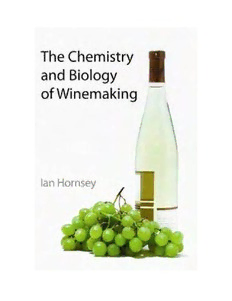
The chemistry and biology of winemaking PDF
Preview The chemistry and biology of winemaking
The Chemistry and Biology of Winemaking Dedication For Bix, Winston and The Oaf. The Chemistry and Biology of Winemaking Ian Hornsey Founder Partner and Launch Head Brewer, Nethergate Brewery ISBN-13:978-0-85404-266-1 AcataloguerecordforthisbookisavailablefromtheBritishLibrary rTheRoyalSocietyofChemistry2007 Allrightsreserved Apartfromfairdealingforthepurposesofresearchfornon-commercialpurposesor forprivatestudy,criticismorreview,aspermittedundertheCopyright,Designsand Patents Act 1988 and the Copyright and Related Rights Regulations 2003, this publication may not be reproduced, stored or transmitted, in any form or by any means,withoutthepriorpermissioninwritingofTheRoyalSocietyofChemistry,or in the case of reproduction in accordance with the terms of licences issued by the Copyright Licensing Agency in the UK, or in accordance with the terms of the licencesissuedbytheappropriateReproductionRightsOrganizationoutsidetheUK. Enquiries concerning reproduction outside the terms stated here should be sent to TheRoyalSocietyofChemistryattheaddressprintedonthispage. Whilsteveryeffort hasbeenmade tocontactthe ownersofcopyrightmaterial, we apologisetoanycopyrightholderswhoserightswemayhaveunwittinglyinfringed. PublishedbyTheRoyalSocietyofChemistry, ThomasGrahamHouse,SciencePark,MiltonRoad, CambridgeCB40WF,UK RegisteredCharityNumber207890 Forfurtherinformationseeourwebsiteatwww.rsc.org Preface There are good reasons for believing that wine has played a prominent role in the civilisation of mankind; indeed, the ancient Greeks regarded anyone who did not imbibe wine as a barbarian. Wemaypresumethatthedrinkwouldhaveplayednosmallpartin the lives of great men such as Archimedes, Pythagoras and Pliny the Elder, and, from a much later era, we know that much of Pasteur’s eminence can be attributed to his studies on ‘the diseases of wine’. This little book aims to show that there is a lot more to viticul- tureandviniculturethanisnormallyconsideredtobethecase.Itis neither merely intended to be a condensed version of some of the excellent, extensive treatises already available, nor, because of the limitations of space, does it include some of the more fashionable topics, such as wine tasting. Rather, it is hoped that the book will introduce the reader to the ways in which the science of oenology, initsbroadestsense,hascontributedtothewell-beingofmankind, andtointimatehowsomeoftheorganismsinvolvedmightplayan important role in his future. Firstandforemost,dueemphasishasbeengiventotheyeastand its ability to undergoethanolic fermentation. Yeasts were active in the environment long before humans came on to the scene and since the advent of man on the planet these microbes have, almost certainly, been an ever-present component of his diet. Over time, yeastshavelearnedtomanipulatehumancellsjustaseffectivelyas humans have exploited the unique properties of yeast cells. Yeasts are the most important organisms in biotechnology, and research with the organism is about to extend the boundaries of functional genomics. The fundamentals of genome variation in yeast are the v vi Preface same as those in humans, and so much useful information can be gleaned from comparative analysis. If we look further into the future,thefirstcomplete‘wiringdiagram’ofacellwillprobablybe for a yeast. By organising genetic information into a wiring dia- gram,theknownfunctionsandinteractionsofgenescanbeusedto generateacomputermodelofalivingcell.Suchdiagramshavethe potential to solve any biological problem, including cellular ap- proaches for the treatment of disease. From a functional point of view, yeasts may be considered to be tiny ‘factories’, capable of producing essentials such as proteins, vitamins and foodstuffs generally. In a slightly different context, the worldwide movement against the use of chemicals in the environment, and aboutour foodstuffs, has meant that man is ever on the lookout for novel means for biological control methods for pests, diseases and contaminants. Killer yeasts, which are dealt with here, show some promise as agents of biological control. Likeitornot,geneticallymodifiedorganismsaregoingtoplaya major role in our future well-being. The bacterium causing crown gall disease of the vine and some other plants has contributed greatlytothewayinwhichplantgenomescanbemodified,andhas taught us much about the infection process. An insight into the relationshipbetweenthebacteriumandthevine,andthebiochemi- stry involved, is presented here. Finally, lactic acid bacteria, some of which are responsible for a secondary wine fermentation, are some of the most versatile mi- crobes known to man, and, as I hope this book indicates, are destined to contribute significantly to biotechnology in the future. Thus,Ihopethattheslightlydifferentslantofcertainsectionsin thisbookwillmakeit usefulto studentsand othersreaders,with a wide range of chemical and biological interests, as well as being of benefit to aficionados with a more perfunctory interest in wine. Contents Introduction 1 Chapter 1 History of Wine 11 1.1 The Prehistory of Wine 11 1.2 Dissemination of Viticulture 15 1.3 The Earliest Chemical Evidence for Ancient Wine 16 1.4 The Holy Land 21 1.5 Egypt 23 1.6 Greece 27 1.7 Romans 33 1.7.1 Resinated Wine 42 1.8 Post-Roman Europe 43 1.9 The New World 50 References 62 Chapter 2 The Vine 65 2.1 The Origin, Taxonomy and Biogeography of the Grapevine 65 2.1.1 Prehistoric Evidence for Vitis 71 2.1.2 Differences between Muscadine Grapes and Euvitis spp. 74 2.2 The Grape and Maturation Processes 78 2.2.1 Berry Structure 79 2.2.2 Developmental Stages of the Grape 85 vii viii Contents 2.2.3 Flavour and Aroma Compounds in the Mature Grape 92 2.2.4 Grape-Derived Phenolic Substances 101 References 112 Chapter 3 The Yeast and Fermentation 114 3.1 The Yeast 114 3.1.1 Taxonomy 115 3.1.2 Cell Structure 117 3.2 Fermentation 132 3.3 Yeast Starter Cultures 156 3.3.1 Bourgovin 157 3.3.2 EC-1118 157 References 158 Chapter 4 Winemaking Processes 161 4.1 Red Wine Production 161 4.1.1 Time of Harvest 162 4.1.2 Harvesting 164 4.1.3 Crushing 166 4.1.4 Fermentation 167 4.2 White Wine Production 170 4.2.1 White Wine Styles 171 4.2.2 Harvesting 172 4.2.3 Crushing 173 4.2.4 Pressing 173 4.2.5 Settling/Clarification 174 4.2.6 Fermentation 174 4.3 Sparkling Wine 174 4.3.1 The Champagne Method 176 4.3.2 The Tank Method 182 4.3.3 The Transfer Method 184 4.3.4 Carbonation 185 4.4 Cold Maceration 187 4.5 Carbonic Maceration 187 Contents ix 4.6 Thermovinification 191 4.7 Chaptalisation 192 4.8 Use of Commercial Enzymes in Winemaking 193 References 201 Chapter 5 Lactic Acid Bacteria and Malo-Lactic Fermentation 203 5.1 Lactic Acid Bacteria 203 5.2 Malo-Lactic Fermentation 223 5.2.1 Urethane (Ethyl Carbamate), and Arginine Metabolism 231 5.2.2 Bacteriophages 237 References 238 Chapter 6 Clarification, Stabilisation and Preservation 242 6.1 Clarification 242 6.1.1 Proteins 246 6.1.2 Polyvinyl Polypyrrolidone 253 6.1.3 Bentonite 255 6.2 Tartaric Acid, Tartrates and Wine Stability 258 6.2.1 Static Cold Stabilisation 264 6.2.2 Contact Cold Stabilisation 264 6.2.3 Ion-Exchange Stabilisation 266 6.2.4 Estimation of Cold Stability 267 6.2.5 Prevention of Crystallisation 269 6.2.6 Protein Instability 271 6.2.7 Assessment of Heat (Protein) Stability 273 6.3 Preservation 274 6.3.1 Sulfur Dioxide 274 6.3.2 Dimethyldicarbonate 286 6.3.3 Sorbic Acid 287 6.3.4 Benzoic Acid 289 References 290
